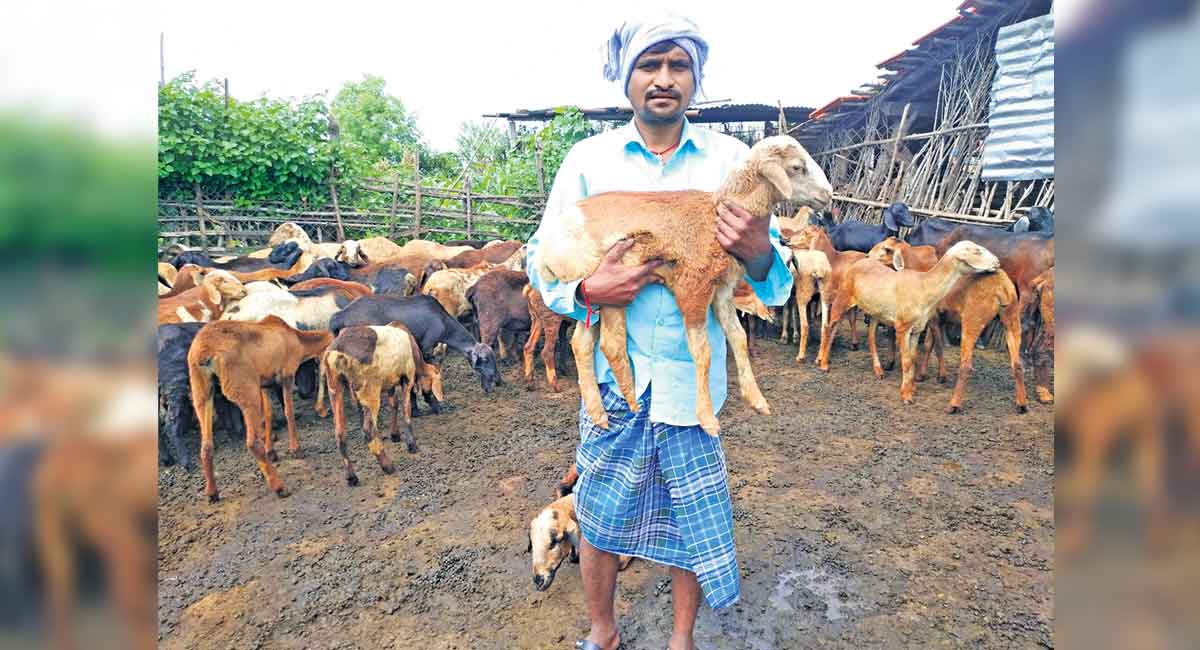Published: Published Date – 11:08 PM, Wed – 15 June 22

After Rajasthan and Jammu and Kashmir, Telangana now
produces the third highest quantity of wool in the country.
Hyderabad: Boina Bhulaxmi is a resident of Mudimanikyam village of Adavidevulapally mandal, Nalgonda. Her husband Chandraiah died in 2017 and she suddenly felt the weight of educating her two sons besides having to perform her daughter’s marriage. Her parents stepped in and gave her 20 sheep and the money they earned through sheep farming was not sufficient to make both ends meet. In 2017, she enrolled under the TRS government’s unique subsidised Sheep Distribution programme aimed at the economic empowerment of the shepherds in the State.
The State government, under the programme, provided her with 20 sheep and a ram that is a complete unit under the scheme, costing Rs 1.25 lakh. The government also provided her with 206 kg feed and Rs 400 worth of medicines. Under the guidance of local veterinary department officials, Bhulaxmi ensured 100 per cent survival of the sheep flock and in six months, the ewes gave birth to 40 lambs including 15 female and 25 male lambs. Bhulaxmai sold 23 male lambs when they reached a body weight of five to seven kg and retained two for breeding. She is presently earning Rs 2.25 lakh per annum.
Bhulaxmi’s success story is not isolated since there are hundreds of families that have benefitted from the sheep distribution programme. Telangana, which has already established itself in a preeminent position in the country in various sectors including IT, pharma, agriculture, and power, among others, has also emerged as a frontrunner in meat production. The State government’s flagship initiative has led to a massive increase in meat production, from 5,05,000 tonnes in 2014-15 to 8,48,000 tonnes in 2019-20. The steps taken by the State government ensured that meat production increased by nearly 40,000 to 50,000 tonnes annually. In 2015-16 the meat production was 5,42,000 tonnes, in 2016-17 it was 5,91,000 tonnes, 2017-18 it was 6,45,000 tonnes, in 2018-19 it was 7,54,000 tonnes and in 2019-20 it escalated to 8,48,000 tonnes.
Incidentally, Telangana is also the third-largest producer of wool in the country. After Rajasthan and Jammu and Kashmir, Telangana now produces the third highest quantity of wool in the country. In 2019-20, 3,96,000 kg of wool was produced in the State. The State government has been emphasising on strengthening the rural economy and its flagship programme of distributing sheep for rearing is helping the shepherd community reap good profits.
About six lakh families are dependent on sheep and goat rearing in the State. The Telangana State Sheep and Goat Development Corporation Cooperative Federation Limited under National Cooperative Development Cooperation (NCDC) assistance are taking up different initiatives aimed at increasing the income of the shepherd community.
At present, there are 8,109 Primary Sheep Breeders Cooperative Societies (PSBCS) with an enrollment of 7,61,895 members. Similarly, there are 12 District Sheep Breeders Cooperative Unions across the State. The Telangana government introduced the sheep distribution programme as a means to increase the rural economy and ensure sustainable livelihood for the shepherds. Under phase I, a family was distributed with 20 sheep with a unit cost of Rs 1.25 lakh on a 75 per cent subsidy and with a total project outlay of Rs 5,000 crore.
About 82.39 lakh sheep were procured from the other States and they were distributed among 3.92 lakh members of PSBCS. Towards this, the State government bore the expenditure cost of Rs 3,735.24 crore as a 75 per cent subsidy and the balance cost of Rs 1245.07 crore was borne by beneficiaries as a 25 per cent share. A total of Rs 4,980.31 crore expenditure was incurred for the implementation of the sheep distribution scheme. As a result of this initiative, the sheep population increased from 1.28 crore to 1.91 crore in the State and this is confirmed by the Central government under the 20th Livestock census. To date, 1.30 crore lambs were born and Rs 6,500 crore worth has been accrued out of the lambs born.
Second phase
Buoyed by the success of the first phase of the sheep distribution scheme, the State government launched the second phase of the distribution. However, considering the escalating transport charges on account of rising fuel prices, the sheep unit cost has been increased from Rs 1.25 lakh to Rs 1.75 lakh. The second phase of implementation is being taken up in 2021-22 and 2022-23 financial years. The government has set a target to cover 3.50 lakh beneficiaries in the second phase. Of the 1.75 lakh unit cost, the government share is Rs 1.31 lakh and the beneficiary share is Rs 43,750. The total financial outlay for the second phase is Rs 6,125 crore with the State government share being Rs 4,593.75 crore (75 per cent) and the beneficiary share being Rs 1,531.25 crore (25 per cent).